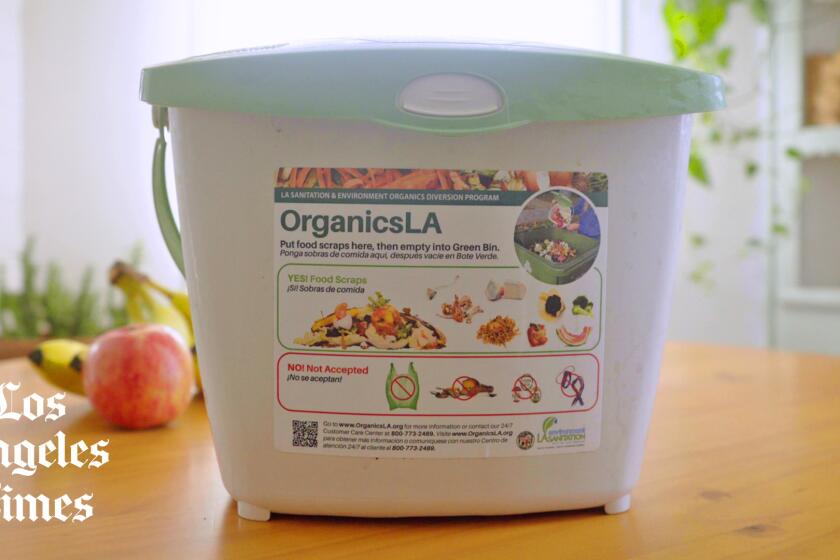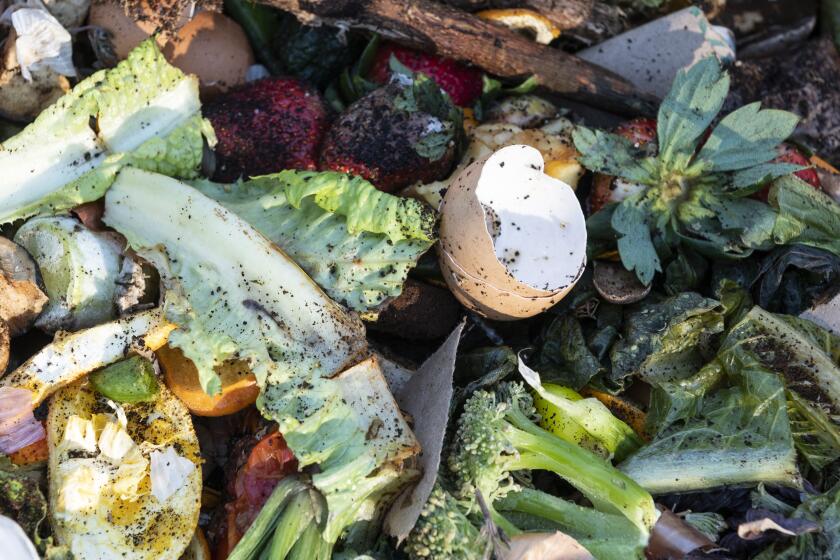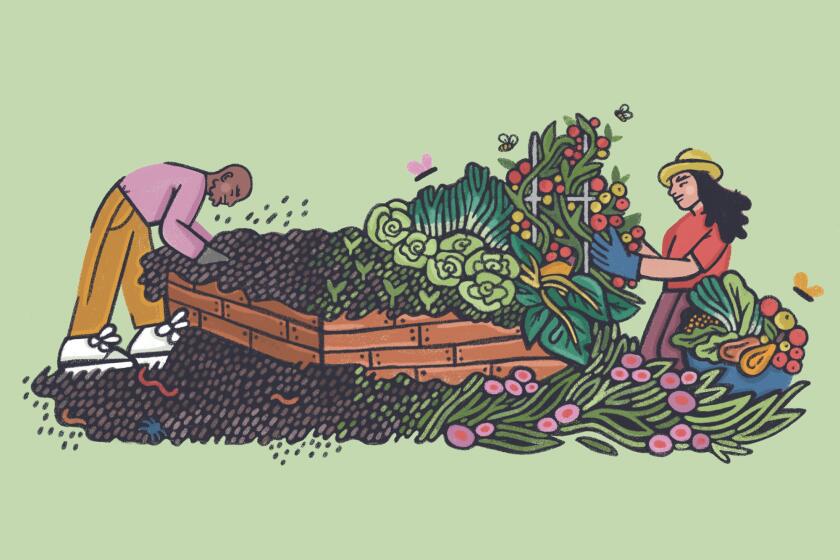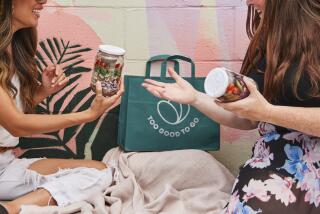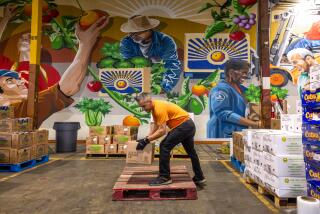Have California’s food waste rules created breeding grounds for bugs at your home? Here’s what to do
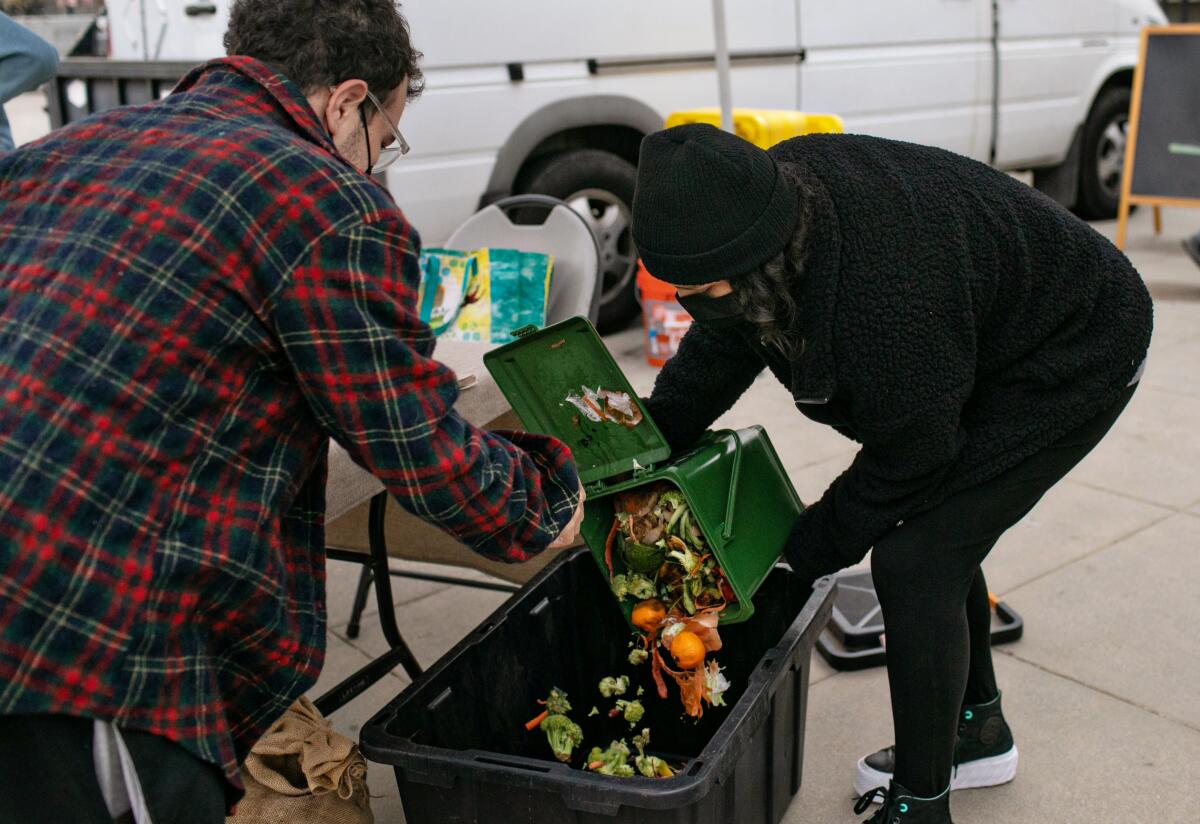
- Share via
It’s that time of the week when your food waste pail is full, and you’re ready to walk your scraps out to the green-waste bin. (You are following your community’s rules about composting food scraps, aren’t you?)
But when you open the bin’s lid, you’re assaulted by a flurry of flies — who are perturbed by your unexpected visit.
These new neighbors, commonly gnats or house flies, are a predictable result of letting food rot in the container, said Gerry Villalobos, environmental specialist for the city of Los Angeles Bureau of Sanitation.
“Until now, food waste has been layered between other materials in the black [trash] bin, preventing insects from accessing food scraps,” he said.
You can replicate that layering in your green bin — and the Bureau of Sanitation encourages it, as long as you use the appropriate items.
Layer food waste between yard trimmings, paper bags, paper-based unlined takeout containers, and other food-soiled paper products.
Schedule a time to pick up your free compost pail from the city — that’s because it’s also time to stop putting food scraps in the trash, as California law requires.
For example, the napkin you used to wipe your mouth after eating a messy sandwich is an accepted soiled paper product. If you’ve got a pizza box stained by grease on one side, cut the box in half: Toss the non-greasy half into the recycle bin, and use the greasy half as a layer in your green-waste bin.
If you don’t do your own gardening, wait for the day landscapers work on your yard — and when they’re done, toss in your food scraps.
Villalobos also suggested waiting to place the food waste in the green bin until the night before or morning of your garbage pickup. One strategy is to freeze your food scraps until trash day.
Clean or rinse out your green bin occasionally — especially if you notice gunk or an odor. If you don’t, “organic waste will build up on the sides and bottom of the green bin, which can result in attracting more insects,” he said.
It’s also a good move to make sure your bin is in good condition — a broken bin or lid is like putting out a welcome mat for insects.
If your bin is damaged, call the Los Angeles Sanitation customer care center at (800) 773-2489 to have your bin replaced or repaired. (If you aren’t served by L.A. City Sanitation, contact your waste hauler.) Have your bin serial number (located on the front of the bin) handy, if possible, Villalobos said.
Landlords are responsible for providing renters with a green bin to comply with California’s composting law.
Other ways to use green waste
You can reduce how much food waste you’re putting in the green bin by finding other ways to use it.
Lauren Bash, a local environmentalist and sustainability content creator, and her mother, Adrianne Ferree, president of the Makers Hub, a Compton-based community maker-space, have been finding ways to compost or use their food scraps for years.
Ferree started 35 years ago by digging a hole in her garden and putting her food scraps in it.
When she worked for the L.A. County Sheriff’s Department, she helped pioneer their recycling, composting and vermiculture (worm-growing) programs through the Education Based Incarceration Bureau.
She recently retired and has continued this lifestyle with her backyard farm in Rancho Palos Verdes, where she’s been growing drought-tolerant produce like artichokes since 2014.
“I remember telling the kids when they were little, we were going to feed the earth, feed the plants,” Ferree said. “So we would always have some kind of little composting, even when we were in a condo.”
Social media is going berserk about SB 1383, California’s new food waste rules. Composting is an easy way you can tackle global warming. Here’s how.
As a homeowner, Ferree has made space to have a composting system in her backyard, and you can too.
She made a turner for her food scraps, using old bicycle wheels and chicken wire, that she layers with mulch and food scraps and turns periodically. Ferree uses the resulting compost to fertilize her garden.
Her daughter, Bash, recently started sharing her indoor vermicompost (worm composting) journey on Instagram and TikTok.
Bash tends to her worms in an 18-by-18-inch, two-tiered bin in her Santa Monica apartment. She blends her food scraps with shredded brown paper, and her worms do the rest.
Bash and Ferree also suggest the following:
- Think about what you really need at the grocery store to avoid overbuying produce. Buy strictly what you need.
- Find a local community garden or compost dropoff location (LA Compost has several sites in Los Angeles County) to donate your food scraps to.
- Seek out recipes — on TikTok, Instagram or in The Times’ recipe database — for the produce you aren’t sure what to do with before it expires. For example, on TikTok, Armen Adamjan recently used watermelon rinds in a smoothie. Also on TikTok, Joe Clark of Garden With Joe made pesto from the tops of radishes and carrots.
- Find someone in your area who has animals, such as bunnies, chickens or horses, and ask whether you can donate unused food scraps.
- Bash makes a veggie broth from her vegetable scraps. She freezes the scraps until she’s ready to pressure cook them in her Instant Pot for 40 minutes. “We eat as seasonally as we can, so it fluctuates. It might taste like corn one week or jalapenos the next week,” she said. She added: “I feel like it’s probably one of the most full-circle processes I get to do every week when I’m extracting every ounce of flavor ... before I compost it, and then it gets to go back to the planet to hopefully create new crops.”
- Recently, Bash made a home cleaning product out of citrus peels. Live Kindly, a sustainable lifestyle brand, shared how to make that cleaner on TikTok.
About The Times Utility Journalism Team
This article is from The Times’ Utility Journalism Team. Our mission is to be essential to the lives of Southern Californians by publishing information that solves problems, answers questions and helps with decision making. We serve audiences in and around Los Angeles — including current Times subscribers and diverse communities that haven’t historically had their needs met by our coverage.
How can we be useful to you and your community? Email utility (at) latimes.com or one of our journalists: Jon Healey, Ada Tseng, Jessica Roy and Karen Garcia.
